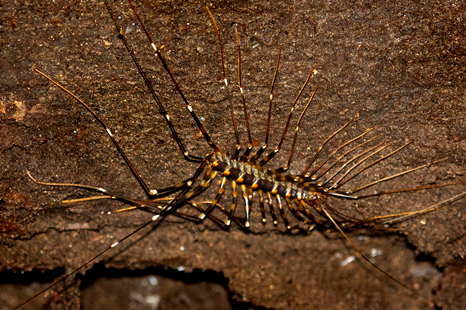Graham Brace travelled on our 'Borneo's Orang-utans' tour and submitted this entry to our writing competition.
Long-legged Centipede by Dani Free
Strange dreams are a common side-effect of the anti-malarial drug Malarone. A week into a Malarone course I was running through a swarm of cockroaches. The air was alive with electric insect noise, and giant centipedes were chasing me. I woke up sweating. This was the night after we visited the Gomantong caves.
It's almost dusk when we arrive at the caves, and from the car park we follow a path through the forest and pause to watch red leaf monkeys. Soon the path widens and across a clearing we can see the giant cave mouth exhaling a plume of vapour into the evening air. Swiftlets are returning to their nests; from this distance they are flickering specks in the sky above the entrance.
Simud Hitam, the Black Cave, is a nesting place for Borneo's edible nest swiftlets. Used to make bird's nest soup, the nests fetch a high price in China, and twice a year licensed collectors climb high up on flimsy rattan ladders to harvest them. We enter the cave on a bridge over a trickle of brown-yellow water. Below us, small crabs paddle in the sludge. A boardwalk clings to the limestone wall. A vast mound of cockroach-infested guano, excreted by generations of roosting wrinkle-lipped bats, covers the floor and gives off a pungent reek of ammonia. The darkness inside the cave seems to amplify the hissing noise of insects.
Our guide Hazwan uses his spotlight to show us a swiftlet on a nest. Cockroaches congregate on the wall, their antennae sweeping back and forth. The boardwalk is slippery: I reach out to steady myself, but the handrail is encrusted with dung and crawling with cockroaches.
‘The cockroaches feed on fallen bats,’ says Hazwan. ‘Maybe young ones ... they lose their grip.’ Out there on the guano there's the broken shape of a dead bat. Its tiny corpse twitches unnaturally. I wonder how many minutes will pass before it disappears into the seething mound.
‘Long-legged centipedes!’ says Hazwan. Their jointed bodies hang from spindly legs, leached of pigment in the glare of the light, long feelers waving. These are giant cave centipedes, as big as my hand, and they have a venomous bite. One scuttles across the wall towards me. I feel an itching on my leg and quickly bend down to tuck my trousers into my socks.
At the back of the cave an opening in the roof 90 metres above shows a patch of daylight. It must be raining outside, I think, the heavy tropical rain that you get here in the afternoons. I can see raindrops falling through shafts of light, large tropical raindrops swirling about in eddies, falling upwards, rain being sucked out of the cave into the sky above. I am disoriented, as if in a dream. This isn't rain, I realise. These are bats. An aerial river of bats is flowing out of the cave. It's like a shift changeover: bats leaving daytime roosts to feed while swiftlets return to their nests for the night. I stand under the opening and tilt my head back. The sky is swarming with bats. And that sound still: white noise, like an old radio tuned between stations; the hiss of insects; a chirruping of bat echo-location (can my ears hear that?); the distant sound of pop music.
What? Can my ears hear pop music?
In the cave's deepest recess is a wooden shelter. In the shelter a man and a woman sit at a low table. It's too dark to see clearly, but they might be playing cards. An old radio is tuned to a music station. I close my eyes. This is a Malarone hallucination; none of this is real. I hear the woman laughing. Everyone else has left the cave. I wander down to the entrance, the sounds of the radio and far-off laughter echoing through the insect noise.
Back at the car park the others are watching a crested serpent eagle in a tree. Bat hawks have come to feed on the flocks emerging from the cave. One of the red leaf monkeys is on the roof of the visitor centre. I'm probably still dreaming, so I ask Hazwan about the people in the shelter at the back of the cave.
‘They guard the nests,’ says Hazwan.
‘Can't they do that from outside?’
‘People come in through the roof.’
A constant watch is kept to prevent poachers abseiling down from above and stealing the nests. I wondered if the guards got used to the dark and the smell, and the sounds, and the bats and the cockroaches. And the centipedes. I didn't think anyone could ever get used the centipedes.
Read more about our 'Borneo's Orang-utans' holiday.



 Loading search...
Loading search...
